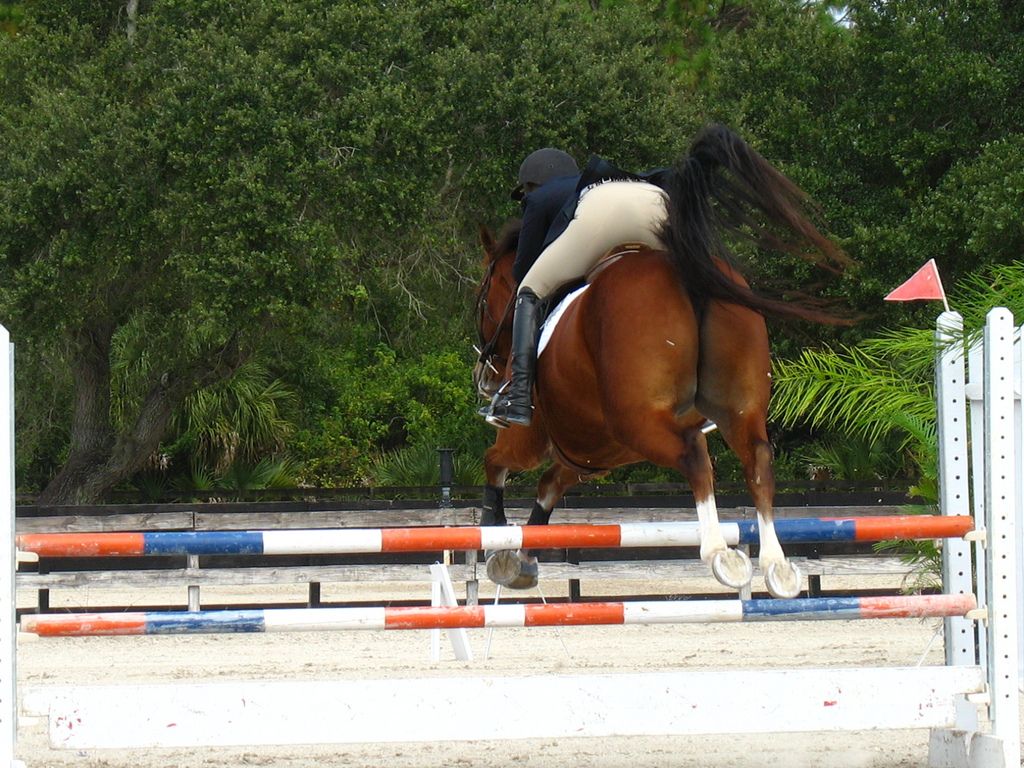In an Olympic cycle that has seen women rise to historic highs with the likes of Simone Biles and Katie Ledecky, let’s turn our attention to the single mixed-gender Olympic sport: equestrianism.
Much has been made about the social implications of gender integration in the sport, but there is little information on why it is physiologically feasible. Make no mistake, horseback riding is an athletically demanding sport. It requires a strong and balanced core, well-developed back and shoulder muscles, and prodigious leg strength. There has been strong opposition toward gender integration in virtually every other sport, yet such integration seems perfectly natural in horseback riding.
One possibility could be that equestrianism is not a sport that requires explosive movements or bursts of energy. Horseback riding demands a prolonged and consistent form; both physical and mental stamina are key. A 2014 study found that horses do not view men and women differently, and that men and women elicited the same physical responses when asked to jump identical courses. It is also worth noting that riders partner with both male and female horses, with neither gender of horse having a clear advantage.
Despite the comparative progressiveness of gender integration, many aspects of the sport still favor male competitors. More men compete professionally than women, which appears to be at odds with the fact that the overwhelming majority of amateur riders are women. Men are also more likely to have powerful positions as federation heads or national team coaches. Most modern equestrian events are derived from military exercises, which were historically the purview of men. Even today, saddles are made with the male anatomy in mind.
A common trope in equestrianism is that “women love horses, men love riding.” The aforementioned 2014 study debunks this, yet it should go without saying that a love of horses is certainly a requirement in order to be successful in this sport. Perhaps even more important than the physical demands are the emotional ones. A good rider must be compassionate and empathetic, and horse and rider pairs share a deep and personal emotional bond. There is also a great deal of trust involved from both parties: the horse must trust that the rider will not push them past their limits, and the rider must trust that this 1500-pound sentient animal will carry them safely. Most pairs at the Olympic level will have been competing together for years, and will have been in training together even before that. Many riders also have their own breeding operations and will raise their mounts from foals.
This year the Olympic equestrian events were especially challenging and dramatic, and are a good jumping-off point for anyone interested in learning more about competitive equestrianism and its unique community.
Under the umbrella of equestrian sports, there are three distinct disciplines in the Olympics: Dressage, Show Jumping, and Eventing. Here is a primer for those who are unfamiliar with the specifics of each event:
Dressage
- Takes place inside an arena “on the flat,” meaning that there is no jumping.
- Horse and rider perform choreographed movements at specific locations throughout the arena.
In the individual competition, riders perform to music. - Points are awarded for style, precision, and artistry.
Show Jumping
- Also takes place inside an arena, using a set course.
- Riders are penalized if they knock down a rail or if their horse refuses a fence. If the rider falls off, they are eliminated.
- The course must be completed within the optimum time, or else the rider will incur time penalties.
- No points are awarded for style.
Eventing
- Combines dressage, show jumping, and cross-country for a multi-day event.
- The cross-country course is laid out over natural terrain and will see horses gallop through forests, trails, and water.
- The obstacles often feature natural resources, such as logs and water elements.
- The course is somewhat fluid, with riders able to make decisions regarding their preferred route.
- Penalties are assessed if a horse refuses a fence. If the rider falls, they are eliminated.
- Failure to complete the course within the optimum time will result in time penalties.
- Riders may compete as part of a four-member team, in which three scores are counted toward the final total.
- Riders on a team also compete as individuals, along with all other riders who are not members of a team.
- No points are awarded for style.
Eventing in Rio
After the first two days of dressage, many of the event’s favorites and defending medal champs found themselves in comfortable positions. However, the cross country phase would prove to shake things up considerably. Designed by prolific course designer Pierre Michelet, Rio’s cross country course was one of the most difficult that riders had ever experienced. Although the Olympics are a four-star competition (the highest rating in equestrian sports), Olympic courses often find themselves somewhat below that, to provide a more even level of competition for the countries that do not have such seasoned programs. That did not seem to be the case with Michelet’s course.
The optimum time for the course was extremely narrow. Horse and rider needed to traverse the 3.62 mile course in 10 minutes and 15 seconds or less. This requires a constant speed of about 21 miles per hour, which is hugely demanding. Many of the fences were at the legal limit for their height and width. Most were particularly unforgiving and required absolute precision. This is further complicated by the fact that, due to their anatomy with their eyes on the sides of their heads, horses cannot see the fence as they jump it. The rider has to be supremely confident and clear in their aids in order to help the horse over. This course punished indecision, and forced riders to reconcile patience and clarity with a mad dash to stay inside the time.
Seventeen horse and rider combinations -- a whopping 25% of the field -- were either unable to complete the course or were eliminated due to a fall or excessive penalties. Among them were 6-time Olympian Karin Donckers from Belgium and 2008 silver medalist Shane Rose from Australia. Only 40.6% of the riders finished without any jumping penalties, down from 67.6% in 2012, which makes this course statistically the toughest Olympic cross country course ever. Team USA fared poorly, as Clark Montgomery retired from competition after his horse, Loughan Glen, had two run-outs, and Lauren Kieffers suffered a nasty rotational fall with her horse, Veronica (both are fine). Only three riders completed the course inside the optimum time and without jumping penalties.
The final phase of show jumping restored many veteran riders to their top form. Michael Jung and Sam FBW from Germany repeated as the individual gold medalists, and were the only pair to not incur any penalties following their initial dressage score. They were followed by France’s Nicolas Astier and Piaf de B’Neville with the silver medal, and USA’s Phillip Dutton and Mighty Nice with the bronze. In the team competition, France brought home the gold medal, followed by Germany and Australia.
Because Germany’s Julia Krajewski was eliminated during cross country, the German team was left without the luxury of a drop score. Sandra Auffarth and Opgun Louvo (the top-ranked pair in the world and the defending bronze medalists) and Ingrid Klimke and Hale-Bob OLD both turned in clutch clear rounds to help secure the silver medal for Team Germany. They finished 11th and 14th, respectively, in the individual competition, and both were on the gold medal-winning team in London 2012, along with Jung.
Dressage
For the fifth consecutive Olympics, women swept the medals in the individual portion of the Dressage competition, the Grand Prix Freestyle. Great Britain’s Charlotte Dujardin and Valegro, the reigning gold medalists and current world record holders, reclaimed the top spot in definitive fashion with a score of 93.857, which was not far off their world record score of 94.300. Germany’s Isabell Werth and Weihegold took the silver on a score of 89.071. Werth is the most decorated Olympic equestrian ever, with six gold and four silver medals to her name. Her teammates, Kristina Bröring-Sprehe and Desperados, took bronze with a score of 87.142. Dujardin was visibly emotional after her winning ride, as it will likely be the last Olympics for Valegro (lovingly known as Blueberry), who is due to be retired soon. The USA’s Lauren Graves and Verdades put in a career-best performance to take the fourth spot with a score of 85.196.
In the team competition, the ever-dominant Germany reclaimed the gold medal after finishing second to Team Great Britain in London 2012. They were led by the standout rides of Ingrid Klimke, Kristina Bröring-Sprehe, and Dorothee Schneider, who all registered scores above 80%. Charlotte Dujardin all but carried Great Britain to their silver medal, with a score of 85.071. Team USA -- who do not typically thrive in dressage events and had not taken home a dressage medal since Athens 2004 -- took the bronze. Lauren Graves anchored the team and received a team-high score of 78.071 to just edge out the Netherlands for third place.
Show Jumping
The equestrian events wrapped up with individual and team Show Jumping. Team France, on the strength of clear rounds by Penelope Leprevost with Flora de Mariposa and Kevin Staut with Reveur de Hurtbise, clinched gold early on. After being shut out of the show jumping medals in 2012, Team USA rebounded with a silver medal. Kent Farrington and Voyeur and Lucy Davis and Barron both jumped clear in the first round, and McLain Ward and Big Star went double clear. Perennial favorite Beezie Madden, who was the 2008 individual bronze medalist and anchor of the gold medal-winning team from the same year, sadly had to withdraw after her horse Cortes ‘C’ suffered a tendon injury. He is expected to make a full recovery. Germany and Canada were tied in third place after the first two rounds, which forced a jump-off. Despite Canada’s best efforts that included a clear round from Tiffany Foster and Triple X IIII, it was eventually Germany that would take the bronze after all their riders jumped clear.
The individual portion of the show jumping competition also proved to be surprisingly difficult, with eight pairs not finishing the course. Among them were Penelope Leprevost and Meredith Michaels-Beerbaum (GER), who had both helped lead their respective teams to medals in the team competition. Great Britain’s Nick Skelton and Big Star, who were on the gold medal-winning team in the London Olympics, took the gold after a speedy jump-off round. He narrowly beat out Sweden’s Peder Fredricson and All In, who finished in the silver spot. Canada’s Eric Lamaze, who won individual gold in Beijing 2008, rode Fine Lady S to the fastest time, but incurred 4 jumping faults, which was good enough for a bronze medal.
If anything, this most recent Olympics should force the federation and equestrians alike to question just how close we are to the "ceiling" of competition. This is becoming increasingly apparent in cross-country in particular, but also in dressage, where Charlotte Dujardin’s world record has not even come close to being equaled. It is fair to say that the stakes are a bit higher for cross-country, as the level of danger is higher. If a teacher administered an exam wherein 25% of the students failed, I would say that the teacher failed in creating a fair test. I hesitate to call Pierre Michelet’s beautiful course at Rio a failure, but perhaps it was a course that belonged in a different competition. At this level we expect the course designer to ask tough questions of horse and rider, but at what point are those answers too elusive to be safe for all participants?
As many pros and veterans faltered, it opened the door for a crop of younger, independent riders from team-less countries to make a name for themselves. Zimbabwe fielded their first-ever equestrian athlete in Camilla Kruger, who jumped clear through cross country, albeit with time penalties. Lauren Billys was the first equestrian athlete from Puerto Rico to compete in Olympic eventing, and although she picked up jumping penalties in the cross country phase, she did complete the competition. Japan’s Yoshiaki Oiwa also jumped clear with time penalties, and eventually finished in the top twenty. It was hugely thrilling to see countries that are typically underrepresented (or not represented at all) have such strong showings, and this may prove to be a trend in Olympics to come.
(Photo credit: Sheri/Flickr)




